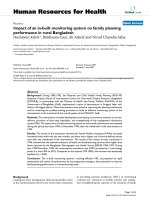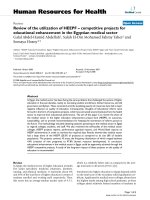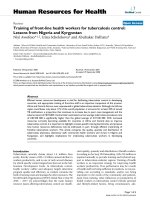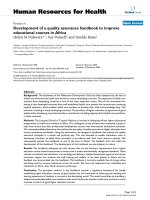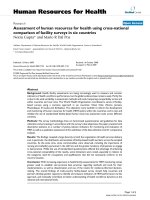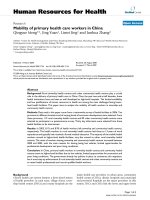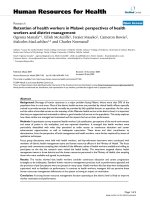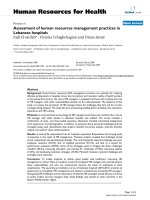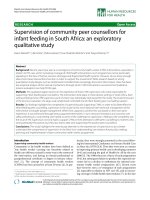Báo cáo sinh học: " Determination of suitable housekeeping genes for normalisation of quantitative real time PCR analysis of cells infected with human immunodeficiency virus and herpes viruses" pdf
Bạn đang xem bản rút gọn của tài liệu. Xem và tải ngay bản đầy đủ của tài liệu tại đây (182.45 KB, 5 trang )
BioMed Central
Page 1 of 5
(page number not for citation purposes)
Virology Journal
Open Access
Methodology
Determination of suitable housekeeping genes for normalisation of
quantitative real time PCR analysis of cells infected with human
immunodeficiency virus and herpes viruses
Sarah Watson
1
, Sarah Mercier
1
, Chris Bye
2
, John Wilkinson
3
,
Anthony L Cunningham
1
and Andrew N Harman*
1
Address:
1
Centre for Virus Research, Westmead Millennium Institute, Sydney, Australia,
2
The Howard Florey Institute, University of Melbourne,
Melbourne, Australia and
3
Biotron Limited, Centre for Immunology, St. Vincent's Hospital, Sydney, Australia
Email: Sarah Watson - ; Sarah Mercier - ; Chris Bye - ;
John Wilkinson - ; Anthony L Cunningham - ;
Andrew N Harman* -
* Corresponding author
Abstract
The choice of an appropriate housekeeping gene for normalisation purposes has now become an
essential requirement when designing QPCR experiments. This is of particular importance when
using QPCR to measure viral and cellular gene transcription levels in the context of viral infections
as viruses can significantly interfere with host cell pathways, the components of which traditional
housekeeping genes often encode. In this study we have determined the reliability of 10
housekeeping genes in context of four heavily studied viral infections; human immunodeficiency
virus type 1, herpes simplex virus type 1, cytomegalovirus and varicella zoster virus infections using
a variety of cell types and virus strains. This provides researchers of these viruses with a shortlist
of potential housekeeping genes to use as normalisers for QPCR experiments.
Background
Quantitative real-time PCR (QPCR) is an invaluable tool
for the measurement of target nucleic acid sequences in
clinical diagnostics and research. The technique is capable
of the relative or absolute quantification of RNA or DNA
sequences in a single sample over a large dynamic range
with extreme sensitivity and accuracy. In virology and
immunology QPCR is used for the relative measurement
of virus and host transcription (gene expression) profiles
in response to viral infection and in the quantification of
viral load in clinical samples and in research [1].
The sensitivity and accuracy of results obtained by QPCR
are dependent on a reliable reference within each sample
to normalise for sample to sample and run to run
variation [2]. These variations arise from differences in
nucleic acid integrity, the efficiency of the reverse tran-
scription of RNA to cDNA and the amount of sample
loaded. References for normalising sample and run varia-
tion include the use of total nucleic acid concentrations,
rRNA concentrations or the simultaneously measurement
of the expression of an individual or select group of genes
termed 'housekeeping' genes, which has become by far
the most commonly used method and is the most reliable
[3]. Housekeeping genes are used under the assumption
that their expression is unchanged in response to the
experimental conditions being investigated. Therefore a
major factor when using QPCR is the selection of
Published: 3 December 2007
Virology Journal 2007, 4:130 doi:10.1186/1743-422X-4-130
Received: 10 October 2007
Accepted: 3 December 2007
This article is available from: />© 2007 Watson et al; licensee BioMed Central Ltd.
This is an Open Access article distributed under the terms of the Creative Commons Attribution License ( />),
which permits unrestricted use, distribution, and reproduction in any medium, provided the original work is properly cited.
Virology Journal
2007, 4:130 />Page 2 of 5
(page number not for citation purposes)
appropriate control genes, as any variation in the
expression of the reference gene between sample groups
will reduce the sensitivity of the assay to detect changes in
the expression of genes of interest and may also produce
artificial changes [3]. Traditionally glyceraldehyde 3-
phosphate dehydrogenase (GAPDH) and β-actin (BACT)
have been most commonly used, however many recent
reports have shown that the expression of these genes can
be variable under several experimental conditions, mak-
ing them inappropriate for use as normalisers [4-7]. In
reality no cellular gene maintains constant expression lev-
els under all conditions and the evaluation of an appro-
priate control gene to normalise QPCR data is therefore
an essential requirement when designing QPCR experi-
ments using new experimental conditions [8]. This is
especially the case when investigating the effects of viruses
on host cell gene expression as viruses can interfere with
host cell pathways, the components of which traditional
housekeeping genes often encode. These include cell
cycle, metabolism, DNA replication and transcription, in
order to aid their replication cycle [9-11]. Studies have
been carried out to determine reliable housekeeping genes
in cells infected with a variety of viruses [7,12], however
to date no such study has been carried out in cells infected
with human immunodeficiency virus (HIV) or the herpes
viruses, herpes simplex virus (HSV) and varicella zoster
virus (VZV). Thus, in this study we have investigated the
suitability of 10 commonly used housekeeping genes for
use as QPCR normalisers in a variety of cell types infected
with a variety of strains of HIV-1, HSV-1, VZV and cytome-
galovirus (CMV) compared to mock infected cells.
Results
A range of cell lines and primary cells were infected with
HIV-1 (BaL, NL4.3, RFW strains), HSV-1 (NC-1 strain),
CMV (Toledo and Towne strains) and VZV (Schenke
strain) and harvested at the earliest time of maximal pro-
ductive infection as illustrated in Table 1. The expression
levels of 10 commonly used QPCR normalisation genes
in both and mock and virally infected cells was deter-
mined by QPCR. The housekeeping genes investigated
were beta-2microglobulin (B2M), peptidylprolyl isomer-
ase A (PPIA), eukaryotic translation elongation factor 1
gamma (EEF1G), succinate dehydrogenase complex sub-
unit A (SDHA), GAPDH, hydroxymethyl-bilane synthase
(HMBS), TATA box-binding protein (TBP), 18s Ribos-
omal RNA (18sRNA), phosphoglycerate kinase 1 (PGK1),
and BACT.
In order to accurately ascertain which housekeeping genes
would be most reliable for use as normalisers in QPCR we
subjected the data to analysis using the GeNorm tool [13]
(Table 2). Using the results from the GeNorm analysis it
was possible to list the housekeeping genes in order of
reliability in the context of each viral infection (Table 3).
18sRNA was the least reliable reference gene as it had had
the highest sum
v
value (13.26) which represents the
standard deviation (SD) of reference gene expression over
all viral infections investigated. Correspondingly it was
either the least or second least reliable gene in 9 of the 10
experimental settings. Additionally BACT and HMBS also
had high sum
v
values of 10.51 and 9.65 respectively, indi-
cating that these genes are generally less reliable for use as
normalisers for QPCR assays. According to this analysis
the most reliable overall reference gene was PP1A with a
sum
v
value of 7.41 and the most reliable gene in 7 of the
10 viral infections. Other genes with low sum
v
values were
SDHA (8.91), GAPDH (8.74), TBP (9.06) and EEF1G
(9.16), though in the context of HSV-1
NC1
infected HELA
cells EEF1G was identified as the least reliable gene. In the
case of CMV an almost identical pattern in reliability was
observed in infected primary HFF cells regardless of differ-
ences in the virus strain used and a very similar pattern
was also seen in VZV
Schenke
infected cells despite differ-
ences in the origin of the primary cell types used for infec-
tion. Though the expression pattern of reference genes in
HELA and HEP2 cells infected with HSV-1
NC-1
were also
similar, it is of note that in HEP2 cells GAPDH was the
second most reliable gene whereas in HELA cells it was the
third most unreliable. The expression pattern of reference
genes in cells infected with HIV-1 was also similar though
greater differences were detected compared to the other
Table 1: Viral strains, infection and cell culture conditions
Virus Strain Cell Type Time Point MOI % Infection
HIV-1 BaL MDDC 48 hr 3 >30
HIV-1 NL4.3 HELA 48 hr 3 >70
HIV-1 NL4.3 HUT78 48 hr 3 >70
HIV-1 RFW HUT78 48 hr 3 >80
HSV-1 NC1 HELA 18 hr 3 >95
HSV-1 NC1 HEP2 18 hr 3 >95
VZV Schenke MDDC 72 hr 0.3 >30
VZV Schenke HFF 72 hr 0.3 >60
CMV Toledo HFF 72 hr 3 >90
CMV Towne HFF 72 hr 3 >90
Virology Journal
2007, 4:130 />Page 3 of 5
(page number not for citation purposes)
viruses, probably reflecting variability in both virus strain
and cell type. Notable differences included 18sRNA being a
relatively reliable gene in MDDCs infected with HIV
BaL
, but
unreliable in other HIV infections and B2M being an unre-
liable reference gene in HIV-1
RFW
infected HUT78 cells only.
Discussion
There are now many reports describing the unreliability
of conventionally used housekeeping genes for the nor-
malisation of QPCR data in certain experimental settings
[4-7,14,15]. Careful consideration must therefore be
carried out when choosing appropriate reference genes
in QPCR experiments and the reliability of a panel of
potential genes should be determined for individual
experimental conditions [3,8]. Ideally the best two or
three of these genes would then be used for normalisation
purposes [16]. This is of particular concern to molecular
virologists as most viruses modulate key cellular processes
which may involve changing the expression of QPCR ref-
erence genes. Different viruses manipulate different cellu-
lar transcription pathways and the extent to which these
pathways are affected will be dependent on the specific
Table 2: Results of GeNorm analysis
Virus Cell B2M PP1A EEF1G SDHA GAPDH HMBS 18sRNA PGK1 B-ACT TBP sum
RGC
HIV-1
BaL
MDDC 0.98 0.78 1.04 1.26 0.83 0.84 0.98 1.09 1.45 0.97 10.22
HIV-
1
NL4.3
HELA 0.84 0.53 0.75 0.88 0.60 0.84 0.93 0.78 0.90 0.72 7.77
HIV-
1
NL4.3
HUT78 1.11 1.18 1.34 0.96 1.35 1.13 2.20 1.20 1.38 1.05 12.90
HIV-
1
RFW
HUT78 1.21 0.64 0.83 0.90 0.99 1.17 1.53 0.87 0.97 1.16 10.27
HSV-
1
NC1
HELA 0.80 0.65 1.33 0.62 0.91 0.59 0.89 0.60 0.92 0.74 8.05
HSV-
1
NC1
HEP2 0.41 0.42 0.44 0.50 0.37 0.38 0.60 0.41 0.57 0.54 4.64
VZV
Schen
ke
MDDC 0.99 0.93 0.96 1.09 0.93 1.23 1.83 1.30 1.02 0.94 12.22
VZV
Schen
ke
HFF 1.56 1.09 1.12 1.34 1.45 1.75 1.94 1.87 1.70 1.54 15.36
CMV
Tow
ne
HFF 0.65 0.58 0.60 0.60 0.82 0.60 1.14 0.58 0.74 0.63 6.8
CMV
Tole
do
HFF 0.86 0.61 0.75 0.76 0.71 0.90 1.22 0.73 0.86 0.77 7.87
sum
v
9.41 7.41 9.16 8.91 8.74 9.65 13.26 9.43 10.51 9.06
The standard deviations of reference gene expression as determined by GeNorm are shown. Abbreviations:. Sum
v
:. Sum of viral infection GeNorm
values; sum
RGC
: sum of reference gene GeNorm values.
Table 3: Reliability of references genes for each viral – cell pair
Virus HIV-1
BaL
HIV-
1
NL4.3
HIV-
1
NL4.3
HIV-
1
RFW
HSV-
1
NC1
HSV-
1
NC1
VZV
Sche
nke
VZV
Sche
nke
CMV
-
Towne
CMV
To-
ledo
Overall
Cell MDDC HELA HUT78 HUT78 HELA HEP2 MDDC HFF HFF HFF -
1st PP1A PP1A SDHA PP1A HMBS HMBS PP1A* PP1A PP1A* PP1A PP1A
2nd GAPDH GAPDH TBP EEFIG PGK1 GAPDH GAPDH* EEFIG PGK1* GAPDH GAPDH
3rd HMBS TBP B2M PGK1 SDHA PGK* TBP SDHA GAPDH*
*
PGK1 SDHA
4th TBP EEFIG HMBS SDHA PP1A B2M* EEF1G GAPDH EEF1G** EEFIG TBP
5th B2M PGK1 PP1A BACT TBP PPIA B2M TBP SDHA** SDHA EEF1G
6th 18sRNA HMBS* PGK1 GAPDH B2M EEF1G BACT B2M TBP TBP B2M
7th EEF1G B2M* EEFIG TBP 18sRNA SDHA SDHA BACT B2M B2M* PGK1
8th PGK1 SDHA GAPDH HMBS GAPDH TBP HMBS HMBS BACT BACT* HMBS
9th SDHA BACT 18sRNA B2M BACT BACT PGK1 PGK1 HMBS HMBS BACT
10th BACT 18sRNA BACT 18sRNA EEFIG 18sRNA 18sRNA 18sRNA 18sRNA 18sRNA 18sRNA
Where two or more genes were equally reliable these are labelled with * or **.
Virology Journal
2007, 4:130 />Page 4 of 5
(page number not for citation purposes)
strain of virus and the cell type infected. Thus it is not
possible to identify a single housekeeping gene for use in
QPCR studies of viral infections. Nevertheless it is of
benefit for researchers to be able to determine a shortlist of
potential candidates. To date the variability of housekeep-
ing gene expression has been studied in cells infected with
SARS corona virus, yellow fever virus, human herpes virus-
6, camelpox virus, CMV [7] and Epstein-Barr virus (EBV)
[12]. However such a study has never been carried out
using the key human pathogens HIV, HSV and VZV. There-
fore in this study we have extended the published investiga-
tions by determining the suitability of 10 commonly used
reference genes in the context of infection with various
strains of HIV-1, HSV-1, CMV and VZV in a range of both
primary and cultured cell lines using the GeNorm tool [13].
We found that overall 18sRNA was the least reliable gene
studied and that BACT was also consistently unreliable.
This correlates with the data from Radonic et al [7] who
found BACT to be the most unreliable of 10 reference
genes studied in a range of 5 viral infections. 18sRNA was
not included in their study however. In contrast Bernas-
coni et al [12] found BACT had the lowest coefficient of
variation of 451 housekeeping genes spotted on microar-
rays in EBV infection in B cells from patients with Burkitt's
lymphoma. It is of note however that the γ-herpes virus
EBV was not included in our study or of that of Radonic et
al though the β-herpes virus CMV and α-herpes viruses
HSV-1 and VZV were. In agreement with Radonic et al we
found that PP1A was the most reliable reference gene
across all infections. However in contrast to their finding
that TBP was equally reliable as PP1A we found it to be the
4
th
most reliable gene. Other reliable genes identified by
our study included GAPDH and SDHA.
A comprehensive literature review of expression studies
published in high-impact journals found that GAPDH,
BACT, 18sRNA and 28sRNA were used as a single control
gene in >90% of cases [13]. However, we found that two of
these (18sRNA and BACT) were the least reliable in the con-
text of the viral infections that we investigated. In contrast
to all other infections, 18sRNA was not an unreliable con-
trol gene when MDDCs were infected with HIV-1
BaL.
In
addition it is of note that although GAPDH was one of the
most reliable reference genes identified overall, it was
the third most unreliable gene in HELA cells infected with
HSV-1
NC1
(whereas it was the second most reliable
reference gene in HEP2 cells infected with the same strain
of HSV-1). These findings therefore highlight the impor-
tance of re-evaluating the choice housekeeping genes when
making even slight changes to experimental settings.
Conclusion
In summary, PPIA, GAPDH and SDHA were the best
QPCR control genes and we would recommend molecular
virologists begin by short listing these genes when
designing QPCR experiments. 18sRNA and BACT were
consistently unreliable and should be used with caution
in studies involving virally infected cells.
Materials and methods
Virus culture
HSV-1 strain NC1, CMV strains Towne and Toledo, VZV
strain Schenke and HIV-1 strains BaL, NL4.3 and RFW
were propagated according to standard protocols [16-20].
The cell types infected, MOI, time of infection and per-
centage of cells infected are shown in table 1. Cells were
infected with each virus strain at a MOI and duration in
order to achieve the maximal percentage of infected cells
as determined by QPCR for all HIV-1, HSV-1 and CMV
infected cells, [21] and by flow cytometry for VZV infected
cells [22].
RNA extraction and DNase treatment
Total RNA from cells derived from four independent
experiments was extracted using the RNAqueous-Midi kit
(Ambion, TA), quantified by UV spectroscopy and the
integrity confirmed using an agilent 2100 bioanalyzer.
1 μg of the total RNA was then DNase treated using 1 U
RNase free DNase (Promega, Madison WI).
cDNA synthesis
cDNA was produced using the Superscript III RT-PCR
System (Invitrogen, Rockville, MD) according to the man-
ufacturer's recommendations for oligo(dT)20
primed cDNA-synthesis. cDNA synthesis from RNA was
performed using 1 μg of RNA, at 50°C. The cDNA was
then treated with RNase H (Invitrogen) and diluted 1:100
before use for QPCR.
Quantitative PCR
In order to measure housekeeping gene expression, cDNA
was subject to QPCR using the platinum QPCR super mix
kit (Invitrogen) and pre-designed certified LUX primers
(Invitrogen) designed to amplify the following tran-
scripts: B2M, PPIA, EEF1G, SDHA, GAPDH, HMBS, TBP,
18sRNA, PGK1, BACT. Fluorescent PCR amplicons were
detected using a Stratagene Mx3005 QPCR thermocycler
using 96-well microtiter plates in a final volume of 25 μl
under the following cycle conditions: 50°C for 2 minutes,
95°C for 2 minute, 45 cycles of 95°C for 15 seconds 55°C
for 30 seconds and 72°C for 30 seconds.
Data analysis
The ΔΔCT [23] method was used for initial data analysis.
Four biological replicates were used for each infection and
a two tailed test with a significance level of 5% was used
to measure the significance between sample replicates.
Repeated measures analysis of variance was then used to
test for the presence of interaction between the effects of
Virology Journal
2007, 4:130 />Page 5 of 5
(page number not for citation purposes)
the within experiment factors for housekeeping gene and
viral status of the cell sample. Data analysis was also
performed using the GeNorm tool [13].
Abbreviations
QPCR, quantitative PCR; CMV, cytomegalovirus; HSV,
herpes simplex virus; VZV, varicella zoster virus; B2M,
beta-2microglobulin; PP1A, peptidylprolyl isomerase A;
EEF1G, eukaryotic translation elongation factor 1 gamma;
SDHA, succinate dehydrogenase complex subunit A;
GAPDH, glyceraldehyde 3-phosphate dehydrogenase;
BACT, beta actin; HMBS, hydroxymethyl-bilane synthase;
TBP, TATA box-binding protein; 18sRNA, 18s Ribosomal
RNA; PGK1, phosphoglycerate kinase 1.
Competing interests
The author(s) declare that they have no competing interests.
Authors' contributions
AH, JW, CB and AC conceived of the study. AH designed
and supervised the experiments, prepared the HIV
infected MDDC extracts, and prepared the manuscript
with CB. SW carried out the QPCR experiments and con-
ducted data analysis with the help of SM. AC provided
intellectual input, and grant funding. All authors read and
approved the final manuscript.
Acknowledgements
We would like to thank the following members of the Centre for Virus
Research for providing infected cell extracts and determining infectivity
rates: Kavitha Gowrishankar and Elizabeth Sloan (VZV), Winnie Garcia
(CMV), Debbie Ko (HSV-1), and Judith Edmonds, Sarah Sherwood, Sabine
Piller and Valerie Marsden (HIV-1). The authors are grateful to Heather
Donaghy for critical reading of the manuscript.
This project was supported by a National Health and Medical Research
Council (NHMRC) Program Grant. ID number 358399.
References
1. Mackay IM, Arden KE, Nitsche A: Real-time PCR in virology.
Nucleic Acids Res 2002, 30(6):1292-1305.
2. Pfaffl MW: A new mathematical model for relative quantifica-
tion in real-time RT-PCR. Nucleic Acids Res 2001, 29(9):e45.
3. Thellin O, Zorzi W, Lakaye B, De Borman B, Coumans B, Hennen G,
Grisar T, Igout A, Heinen E: Housekeeping genes as internal
standards: use and limits. J Biotechnol 1999, 75(2–3):291-295.
4. Glare EM, Divjak M, Bailey MJ, Walters EH: beta-Actin and
GAPDH housekeeping gene expression in asthmatic airways
is variable and not suitable for normalising mRNA levels.
Thorax 2002, 57(9):765-770.
5. Selvey S, Thompson EW, Matthaei K, Lea RA, Irving MG, Griffiths LR:
Beta-actin–an unsuitable internal control for RT-PCR. Mol
Cell Probes 2001, 15(5):307-311.
6. Zhong H, Simons JW: Direct comparison of GAPDH, beta-
actin, cyclophilin, and 28S rRNA as internal standards for
quantifying RNA levels under hypoxia. Biochem Biophys Res
Commun 1999, 259(3):523-526.
7. Radonic A, Thulke S, Bae HG, Muller MA, Siegert W, Nitsche A: Ref-
erence gene selection for quantitative real-time PCR analy-
sis in virus infected cells: SARS corona virus, Yellow fever
virus, Human Herpesvirus-6, Camelpox virus and Cytomeg-
alovirus infections. Virol J 2005, 2:7.
8. Radonic A, Thulke S, Mackay IM, Landt O, Siegert W, Nitsche A:
Guideline to reference gene selection for quantitative real-
time PCR. Biochem Biophys Res Commun 2004, 313(4):856-862.
9. Kalejta RF, Shenk T: Manipulation of the cell cycle by human
cytomegalovirus. Front Biosci 2002, 7:d295-306.
10. Schang LM: The cell cycle, cyclin-dependent kinases, and viral
infections: new horizons and unexpected connections. Prog
Cell Cycle Res 2003, 5:103-124.
11. Hayward SD, Liu J, Fujimuro M: Notch and Wnt signaling: mim-
icry and manipulation by gamma herpesviruses. Sci STKE
2006, 2006(335):re4.
12. Bernasconi M, Berger C, Sigrist JA, Bonanomi A, Sobek J, Niggli FK,
Nadal D: Quantitative profiling of housekeeping and Epstein-
Barr virus gene transcription in Burkitt lymphoma cell lines
using an oligonucleotide microarray. Virol J 2006, 3:
43.
13. Vandesompele J, De Preter K, Pattyn F, Poppe B, Van Roy N, De
Paepe A, Speleman F: Accurate normalization of real-time
quantitative RT-PCR data by geometric averaging of multi-
ple internal control genes. Genome Biol 2002,
3(7):RESEARCH0034.
14. Hsiao LL, Dangond F, Yoshida T, Hong R, Jensen RV, Misra J, Dillon
W, Lee KF, Clark KE, Haverty P, et al.: A compendium of gene
expression in normal human tissues. Physiol Genomics 2001,
7(2):97-104.
15. Warrington JA, Nair A, Mahadevappa M, Tsyganskaya M: Compari-
son of human adult and fetal expression and identification of
535 housekeeping/maintenance genes. Physiol Genomics 2000,
2(3):143-147.
16. Harman AN, Wilkinson J, Bye CR, Bosnjak L, Stern JL, Nicholle M, Lai
J, Cunningham AL: HIV induces maturation of monocyte-
derived dendritic cells and Langerhans cells. J Immunol 2006,
177(10):7103-7113.
17. Diefenbach RJ, Miranda-Saksena M, Diefenbach E, Holland DJ, Boadle
RA, Armati PJ, Cunningham AL: Herpes simplex virus tegument
protein US11 interacts with conventional kinesin heavy
chain. J Virol 2002, 76(7):3282-3291.
18. Willemsen NM, Hitchen EM, Bodetti TJ, Apolloni A, Warrilow D,
Piller SC, Harrich D: Protein methylation is required to main-
tain optimal HIV-1 infectivity. Retrovirology 2006, 3:92.
19. Gowrishankar K, Slobedman B, Cunningham AL, Miranda-Saksena M,
Boadle RA, Abendroth A: Productive varicella-zoster virus
infection of cultured intact human Ganglia. J Virol 2007,
81(12):6752-6756.
20. Jones DR, Suzuki K, Piller SC: A 100-amino acid truncation in the
cytoplasmic tail of glycoprotein 41 in the reference HIV type
1 strain RF. AIDS Res Hum Retroviruses 2002, 18(7):513-517.
21. Roback JD, Hillyer CD, Drew WL, Laycock ME, Luka J, Mocarski ES,
Slobedman B, Smith JW, Soderberg-Naucler C, Todd DS, et al.: Mul-
ticenter evaluation of PCR methods for detecting CMV DNA
in blood donors. Transfusion 2001, 41(10):1249-1257.
22. Morrow G, Slobedman B, Cunningham AL, Abendroth A: Varicella-
zoster virus productively infects mature dendritic cells and
alters their immune function. J Virol 2003, 77(8):4950-4959.
23. Livak KJ, Schmittgen TD: Analysis of relative gene expression
data using real-time quantitative PCR and the 2(-Delta Delta
C(T)) Method. Methods
2001, 25(4):402-408.
Publish with BioMed Central and every
scientist can read your work free of charge
"BioMed Central will be the most significant development for
disseminating the results of biomedical research in our lifetime."
Sir Paul Nurse, Cancer Research UK
Your research papers will be:
available free of charge to the entire biomedical community
peer reviewed and published immediately upon acceptance
cited in PubMed and archived on PubMed Central
yours — you keep the copyright
Submit your manuscript here:
/>BioMedcentral
